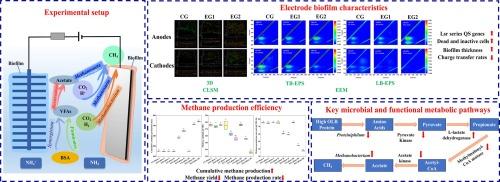In-depth exploration of microbial electrolysis cell coupled with anaerobic digestion (MEC-AD) for methanogenesis in treating protein wastewater at high organic loading rates
IF 9.9
1区 工程技术
Q1 ENERGY & FUELS
引用次数: 0
Abstract
High concentrations of protein wastewater often reduce treatment efficiency due to ammonia inhibition and acid accumulation caused by its low carbon-to-nitrogen ratio (C/N) after digestion, as well as its complex structure. This study investigates the performance of a microbial electrolysis cell (MEC) driving a protein digestion system with gradually increasing organic loading rates (OLR) of bovine serum albumin, elucidating microbial changes and methanogenic metabolic pathways on bioelectrodes under high OLR “inhibited steady-state” (ISS) conditions. The results showed that the accumulation of ammonia nitrogen (AN) from protein hydrolysis under high OLR conditions disrupted microbial growth and caused cell death on the electrode surface, hindering the electron transfer rate. Toxic AN reduced protein hydrolysis, led to propionate accumulation, inhibiting the acetoclastic methanogenesis process and favoring the hydrogenotrophic pathway. As OLR increased from 6 to 11 gCOD/L, cumulative methane production increased significantly from 450.24 mL to 738.72 mL, while average methane yield and production rate decreased by 10.51 % and 50.28 %, from 375.20 mL/gCOD and 75.04 mL/(gCOD·d) to 335.78 mL/gCOD and 37.31 mL/(gCOD·d), respectively. Despite these declines, the system maintained an ISS. Moderate OLR increases can achieve an ISS, boosting protein waste treatment capacity, methane production, and net energy output (NEO), with an OLR of 6 gCOD/L being optimal for maximizing NEO per unit substrate. These findings provide theoretical insights into the methanogenesis pathway of high OLR proteins in MEC-AD systems and offer an effective method for treating high OLR protein wastewater in future practical applications.

深入探讨微生物电解池与厌氧消化(MEC-AD)在处理高有机负荷率蛋白质废水中的产甲烷过程
高浓度的蛋白质废水往往会降低处理效率,原因在于其消化后的低碳氮比(C/N)以及复杂的结构会导致氨抑制和酸积累。本研究调查了微生物电解池(MEC)在牛血清白蛋白有机负荷率(OLR)逐渐增加的情况下驱动蛋白质消化系统的性能,阐明了高 OLR "抑制稳态"(ISS)条件下生物电极上的微生物变化和产甲烷代谢途径。结果表明,在高 OLR 条件下,蛋白质水解产生的氨氮(AN)积累破坏了微生物的生长,导致电极表面细胞死亡,阻碍了电子传递速率。有毒的氨氮减少了蛋白质水解,导致丙酸盐积累,抑制了乙酰甲烷生成过程,有利于养氢途径。当 OLR 从 6 gCOD/L 增加到 11 gCOD/L 时,累积甲烷产量从 450.24 mL 显著增加到 738.72 mL,而平均甲烷产量和生产率分别从 375.20 mL/gCOD 和 75.04 mL/(gCOD-d) 下降到 335.78 mL/gCOD 和 37.31 mL/(gCOD-d),降幅分别为 10.51 % 和 50.28 %。尽管出现了这些下降,但系统仍保持了 ISS。适度增加 OLR 可实现 ISS,提高蛋白质废物处理能力、甲烷产量和净能源产出(NEO),其中 6 gCOD/L 的 OLR 是单位基质净能源产出最大化的最佳值。这些发现为 MEC-AD 系统中高 OLR 蛋白质的产甲烷途径提供了理论依据,并为未来实际应用中处理高 OLR 蛋白质废水提供了有效方法。
本文章由计算机程序翻译,如有差异,请以英文原文为准。
求助全文
约1分钟内获得全文
求助全文
来源期刊

Energy Conversion and Management
工程技术-力学
CiteScore
19.00
自引率
11.50%
发文量
1304
审稿时长
17 days
期刊介绍:
The journal Energy Conversion and Management provides a forum for publishing original contributions and comprehensive technical review articles of interdisciplinary and original research on all important energy topics.
The topics considered include energy generation, utilization, conversion, storage, transmission, conservation, management and sustainability. These topics typically involve various types of energy such as mechanical, thermal, nuclear, chemical, electromagnetic, magnetic and electric. These energy types cover all known energy resources, including renewable resources (e.g., solar, bio, hydro, wind, geothermal and ocean energy), fossil fuels and nuclear resources.
 求助内容:
求助内容: 应助结果提醒方式:
应助结果提醒方式:


